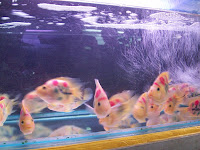Let's go shopping for a pet
In the morning we boarded our bus and headed for a Pet and Garden Center in Xi'an.
We visited the garden section first.
Potted Lemon Trees.
Jade trees.
This is an unusual plant called Buddha's Hands.
There were all kinds of plants and flowers for both home and garden.
After inspecting all of the plants and flowers it was time to get a look at the pets.
Only recently have cats and dogs started to become accepted as family pets.
More about pet cats and dogs in China today.
Traditionally, and still today, the most common pets are song birds, fish, lizards, turtles, crickets, grasshoppers and hamsters.
Traditionally animals of all kinds have been looked upon more as sources of food than pets. Having an animal for the simple pleasure of owning and loving it was a luxury that only the richest people could afford. Rats have traditionally done well in China because their natural predators—cats and snakes—are considered delicacies.
In the imperial era animals were largely looked upon as either pests, protection against pests or food. In the Mao era, pets were looked upon as decadent, bourgeois and imperialistic. During the Cultural Revolution there wasn’t enough food for people, let alone dogs, China was very poor and pets were not allowed.
In recent years it has become more common for people to own pets, especially in the cities where a surprisingly number of people live alone and may find it comforting to have a pet at home. An average Chinese city has about 100,000 dogs and gains about 10,000 per year, while large cities can have twice as many. Beijing had more than 500,000 pet dogs in 2004.
Cats are more easily tolerated than dogs by authorities because they consume less food than dogs, but like dogs they are sometimes consumed as food as they are in Korea and Vietnam. The tradition of eating dogs and cats is under fire today by Chinese officials.
Among middle class Chinese cats are increasingly being sought after as pets because they are easy to take care of and are less regulated less than dogs. In Beijing one can see people looking enchantedly and longingly at kittens in the windows of pet shops that specialize in cats.
After Mao died in 1976 dog ownership was tolerated. Deng Xiaoping reportedly had a couple of small pet dogs, and rich Chinese began buying dogs as a status symbol and "a way of showing off."
Mao would be turning in his grave at the site of such 'decadent' Chinese pet owners today.
Confucius kept a cat. There is a man in his 70s, Ding Shiying, who shares his 160-square meter home in Beijing with 160 cats, most of them strays. He took in his first cat in 1982 when he retired from his job in a medical office in a university and needed a “roommate.” In 2005, he told a Japanese newspaper, “I don’t feel lonely now that I have so many kitties.” Unlike dogs, cats are not licensed and no one knows how many of them there are. By one estimate there are 500,000 to 600,000 cats in Beijing. Cats are often found hanging out in alleys around garbage cans and are regarded by many as pests.
Lots of these critters need special food like worms and such.
Along with this trend is the high number of pets on the streets that have been abandoned by owners. The number of stray cats and dogs in Beijing has increased dramatically in recent years. Many of which belonged to people who tired quickly of the novelty of having a pet and simply let the animals go or to people who moved to apartments where pets were not allowed. In the vicinity of some apartment complex the number of stray cats has jumped form near zero to 70 within a couple years.
Up Next:
The Old City Wall of Xi'an






































.jpg)















Wonderful plants and trees but abominable treatment of "pets". The confinement of rabbits, hampsters, turtles in cages that permit no movement nor space for food or water and the too full fish tanks are extremely inhumane. Dying the pet dogs is not only in poor taste, it is harmful to their health. China like most Asian Countries has a history of cruelty to dogs and cats used for food (beaten to death, boiled alive, etc.) and continues as one of the most barbarous when it comes to fur animals. Truly heartrending to see some of your images and contemplate the fate of so many abandoned / stray animals.
ReplyDelete